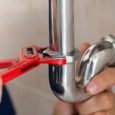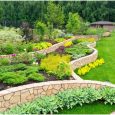At this point in life, no one doubts how healthy and delicious it is to grow our own food. If we are lucky enough to have a garden or even a patio or terrace, we can make our own garden easily, simply and with inexpensive materials. Of course, you will have to take care of the sowing process if you want to obtain a harvest like that of a true gardener. Other times we have already told you how to take advantage of spaces in your home to plant some species. Now you only need a small corner in your garden, which does not need to be very large, but it does have to receive enough sunlight during the day, so that by cultivating the tips that we present below you can show off your own garden without leaving home. Also follow the link to make your grow box: https://modernliving101.com/how-to-make-grow-box/

-
Delimit spaces with fences or fences
An elegant way to share and distribute orchard and garden is to establish the separations between each of the environments and areas of use. You can corner the garden in a certain area and by means of a fence limit its surface, differentiating it from the rest of the garden. Try not to mix the plants and flowers with the growing area, and above all, keep the garden away from the temptations of any neighbour.
-
Enable niches for each species
A good idea is to separate the species you want to plant in different pots or growing spaces. Each seed may need different conditions and a different cultivation process, type of soil, light and avoid competing with each other by weakening each other. With this system you will get a more personalized treatment for each of them.
-
Nourishes the soil well
You already know that before sowing you have to prepare the ground. Move the earth so that it softens and oxygenates, this you have to do with the help of a shovel, pillory and rake. You have to clean the place so that it is free of stones, weeds and grass and only loose soil remains. Then add leaf soil and compost to the garden, the layer should be between 2 and 10 cm high; if you want to add compost, the food will have more nutrients but keep in mind that the smell will be stronger and will attract some insects.
-
Choose the right species
There is an extraordinary assortment of vegetables and herbs to grow. Today, you can count on early, late or mid-season varieties at the same time; normal or dwarf; fast growing or normal growing. Look for the most appropriate varieties for the climate and soil in your area. The soil you have is also very important. For example, cauliflower will not do well in sandy, depleted soil. To start, it will be better to try a few varieties and improve as you gain experience.
-
Look for organic seeds
One of the most important things in a garden is the seeds. Good seeds will help you have better germination, growth, harvest and subsequent seeds. When we make our first garden, we usually buy the seeds by sachet at any store, and that’s not bad to start with. But in the long run, it is advisable to have your own seeds or look for places where they sell organic seeds since they assure you that they have not been treated with chemicals or genetically manipulated for specific climates, in addition, your future harvest will be of higher quality.
-
Use vines and vertical garden
The possibility of giving verticality to the garden is something that will facilitate the work and the harvest and will also create an attractive aesthetic construction. Something that must be taken into account from the beginning is that when we are going to install a vertical garden, it is important to define from the beginning what type of vegetables, greens or plants we are going to grow. This will be what makes us decide on one structure design or another. For example, it is not the same to want to grow radishes, green beans or artichokes, since the space and the depth must be different. Another factor to take into account is the weather seasons and the months of the year. Depending on the month we meet, it will be more convenient to cultivate one type of species or another.




